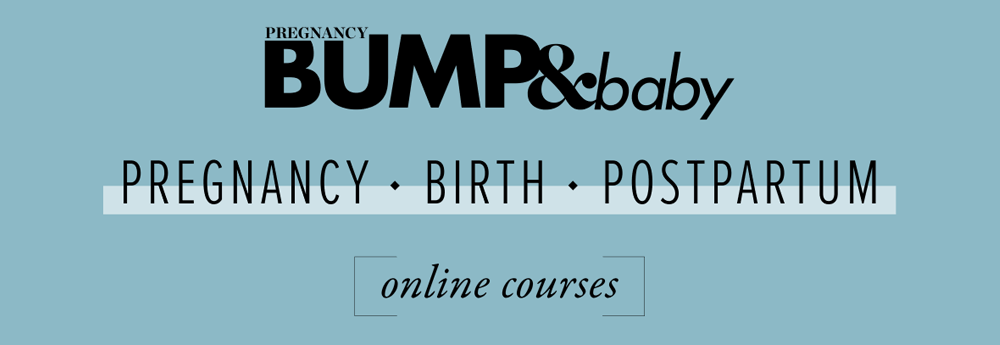
This month, your energy should continue to increase, although you may also have a few more aches and pains as your ligaments stretch. You may also experience two of the less-pleasant side effects of pregnancy: Heartburn and reflux. They often come at the same time your appetite has started to ramp up and cravings set in. Try to avoid triggers like spicy, fried, or fatty foods; eat smaller meals more frequently; and keep a supply of pregnancy-safe antacid tablets or liquid nearby. Check with your midwife or pharmacist about what is safe to take during pregnancy. You may also experience mild oedema (swelling) of your feet and ankles. This is normal, but if the swelling seems to be more than mild or it doesn’t go away, talk to your LMC as it can be a sign of something more serious. The dreaded “preggy brain” can set in with a vengeance, and you might find yourself putting your car keys away in the fridge.
How big is my baby?
Your baby has grown enough that you’re starting to look pregnant, which is a milestone for many mums-to-be. At the beginning of this month, your baby is 14cm long and weighs around 140g (about as much as a chicken breast), and by the end of this month, your baby is about 20cm long and weighs a whopping 450g – almost as much as a block of butter! He or she is covered in vernix, which is a greasy, cheeselike, white substance that protects your baby’s skin from the surrounding amniotic fluid. This coating will shed closer to the birth, but many babies are born with remnants of vernix on their skin. Your baby’s sex organs are also becoming more easily discernible, and if you’re having a girl, her vaginal canal will have begun developing. If you’re having a boy, his testicles have begun to descend from his abdomen and will soon drop into his scrotum.
Anatomy scan
At between 18 and 20 weeks of pregnancy, preferably as close as possible to 19 weeks, you will have another routine ultrasound, commonly called the anatomy scan. This scan assesses whether your baby is growing and developing normally. It takes around 30 minutes, and during the scan, the technician will take various measurements and look for a number of characteristics, such as the fluid around your baby, the placenta, and your baby’s head, face, spine, heart, stomach, bowels, kidneys, bladder, and limbs.
This scan can be a little uncomfortable because you will need to have a full bladder beforehand – but the payoff is that at this scan, if you wish to find out your baby’s gender, it may be visible! Let the technician know before the scan whether you wish to find out the gender or not. Keep in mind it may not be possible to see the baby’s gender due to the position he or she is in, and other factors.
Little flutters
If it’s your first pregnancy, you might start feeling your baby move around your fifth month of pregnancy. It may start off feeling like little flutters or gentle bumps, as though your stomach is growling (although without the accompanying noise!), or even like gas – and you may not even notice for a while, or you’ll suddenly realise what you’re feeling! As your baby grows, these movements will become more discernible and you may even start to see a pattern of when your baby is awake and asleep. Later on in pregnancy, you’ll even be able to see the movements from the outside, and your partner will particularly enjoy feeling your baby shifting and kicking.
Tooth or consequences
Has your mouth become a disaster zone, with bleeding gums, super-sensitive taste buds, and gagging every time you brush your teeth? Pregnancy hormones aren’t particularly kind to your gums, which become inflamed and swollen and tend to bleed even with the gentlest brushing. Your hormones are also responsible for your taste buds going a bit wild. And gagging when you brush your teeth may be a leftover from morning sickness, and again is hormonal. All of these symptoms will ease when your baby is born, but until then, keep brushing and flossing, and see your dentist if you notice any cavities or other tooth difficulties (be certain to tell your dentist you’re pregnant).
QUICK FACTS
WEEK 18: Your baby is the size of a chicken breast (14cm, 140g) and can yawn and hiccup.
WEEK 19: Your baby is the size of a mango (15cm, 225g) and is starting to grow hair!
WEEK 20: Your baby is the size of a banana (16.5cm, 300g) and has eyebrows.
WEEK 21: Your baby is the size of a carrot (18cm, 325g) and is practising swallowing and digesting.
WEEK 22: Your baby is just smaller than a block of butter (20cm, 450g) and can now perceive light and dark.
BUMP&baby
BUMP & baby is New Zealand’s only magazine for pregnancy and early babyhood. Our team of mums and mums-to-be understand what it’s like to be pregnant in this connected age, and that’s why BUMP & Baby online is geared toward what pregnant women and new mums really want to know.
Other articles of interest
Month 3 (weeks 9-13)
You’ll notice visible changes in your body this month, because your baby is reaching some significant developmental…







